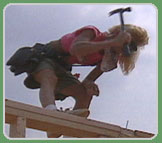 |
|
| Chapter 1: |
Women's house falls behind |
 |
|
| Chapter 2: |
One thorny dilemma |
 |
|
| Chapter 3: |
A Nader Home Inspection |
 |
|
| Chapter 4: |
Habitat's first hammer - Jimmy Carter? |
 |
|
| In order to view the video or the stills you need to have RealPlayer installed. |
|
|
Blitz Houses Built in 5 Days
By Stew Harris
Washington DC, June 19-- Easing the affordable housing crunch was a goal, to
be sure. But a team of tool-toting women also planned to prove that they
could keep pace with the brawniest male homebuilders at this Habitat for
Humanity construction project in Washington DC.
The dueling ground was to be muddy stretch of land off Benning Road in
one of this city's toughest corners. The all-woman team would tackle
construction of one of 10 houses to be built in just four and a half days.
Volunteers with Habitat for Humanity call them "Blitz houses," for the
fury with which these single-family dwellings are built. The faith-based
non-profit organizes dozens of such worksites every year.
But this one would be different. Just 10 minutes from the U.S. Capital,
powerful lawyers were to labor under the direction of humble tradespeople --
and one very low key ex-president: Jimmy Carter. Carter and his wife
Rosalyn work one Habitat project each year.
"You know, we don't give anything away except a little companionship and
partnership and affection," Carter told The Public WebWorks. "The families
put in 100s of hours on their own homes. The families have to pay the full
price of the house, but they don't have to pay any profit and they don't
have to pay any interest." (See video of Carter interview with Ralph Nader)
That's how Almeada Allen and her three children were able to afford the
Habitat blitz house being built by the all-woman crew assembled at worksite
number 10.
"I won't have to worry about them going to a play area a couple blocks
away," said Allen, who is moving her kids from an apartment building. "They
can play in the back yard or sideyard," she said, pointing to the where a
yard will surround unbuilt home.
Trouble is, after day one, the women's house had fallen badly behind
schedule and the women were debating whether they would any help from men
catch up.
Pacing nervously, Clara Faulk did not look happy. Faulk broke into the
construction business years ago by offering her carpentry skills for free
until foremen were convinced she could carry her share.
By the end of day one, the reed thin blonde was arguing with her
forewoman. She was seeking permission to stay on the job and finish those
first-day tasks that the all-woman crew failed to complete. The women's
house stood behind her, four studded walls without a roof. Twenty feet
away began a line of nine other blitz houses, each with roof trusses neatly
installed and exterior sheathing in place.
"C'mon, I can put my hair under my helmet and nobody will know I'm a
woman," Faulk pleaded. It was an obvious point of pride.
"We need you fresh and rested for tomorrow," said Mary Olive Johnson,
looking up at Faulk's tanned face.
A television news crew maneuvered to capture their exchange. The two
smiled, embarrassed. "Hey, will you get out of here!" Faulk said, gently
guiding the crew away.
Faulk got her way and worked until 10 p.m. with a crew of men assigned to
the "elves shift." It was a 16 hour day.
The next morning, back at the worksite, she was hoarse.
"You know, these ladies type and they're housewives and they don't do
physical stuff every day," Faulk said. "So it was rough on them--extremely
rough. But they hung in there and they didn't go sit in the car."
Each successive day, the women came closer to keeping up with the blitz
schedule. By the last day, spirits were high as they rolled paint over
interior walls and sod across the yard. The house was completed on time.
Each house is sponsored by a different corporation or organization which
raises $50,000 for materials. The women's house was sponsored by the
American Legion Women's Auxiliary while other houses were sponsored by
banks, utilities and unions.
|